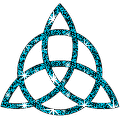Anyway, I wanted to share this article with you all. I hope that you all will find it as enlightening as I did.
Have a great week.
*************************************************************************************

Beyond Power Yoga
From "Beyond Power Yoga: 8 Levels of Practice for Body and Soul" by Beryl Bender Birch
Posted by: DailyOM
One night, after I got back to California, I was on my way home from a yoga class. I was sitting in the backseat of a car thinking about going to India. At the moment, I was actually visualizing climbing a mountainside covered with wildflowers in the foothills of the Himalayas (which, not coincidentally, I would eventually do). My friend turned to me and said, "You want to go to India, don't you?" This was too freaky! "Uh, yeah," I mumbled. "Well, you'll go," she said. A year later I was on my way. How did this work? Was it just a question of creating a thought form, and then holding that until it began to manifest? I starting tracing back the string of events of the past year or so. Every event had contributed to every other event. Everything was interconnected. If it hadn't been for this, then that wouldn't have happened. If it hadn't been for that, then this wouldn't have happened. It started to dawn on me how this all worked. I started to watch a little more closely what I envisioned and asked for.
My father is dying; an Indian yogi materializes to answer my questions about death and dying. I almost die in a blizzard and a dog that as a puppy was adopted, and inexplicably returned three times in a week before he ended up with me, saves my life. I dream of going to India and haven't a dime for the trip. Suddenly I have $1,500, which is exactly how much I need to buy my plane ticket and go to India for four months. As I look back at all of this, I can see that it never occurred to me that I wouldn't get answers and action in response to the questions I asked. As a child, I was in the habit of asking God questions and expecting answers. It never occurred to me that God wouldn't explain to me about my father. It never occurred to me that I wouldn't make it to Colorado. And it never occurred to me that I wouldn't go to India.
If I had stopped to figure it out in a linear or logical way, then I would have seen that since I was earning only $5 an hour, it was clearly going to take a very long time to get this trip together. But I didn't think like that. I just assumed that if God wanted me to go to India, God would come up with the money, somehow. I didn't put a logical limit, in terms of either time or effort, on how it was supposed to come. I just figured it would be there when I needed it and I went ahead with my plans. The next thing I knew it was time to go, and I sold my Volkswagen van for $500, sold an article I wrote on acupuncture for $500, and was given a $500 scholarship to go to India from a yoga school where I was studying. Practically overnight, I had $1,500.
It started to dawn on me that there was nothing that wasn't possible, and I started to live my life like that. Perhaps that is why I was so na?ve when I first went to India. It never occurred to me that anything bad would happen, so that construct of reality didn't exist for me. Luckily, God covered my ass.
THE PAYBACK IN MANALI
Every twelve years in India there is a huge spiritual festival called Kumbha Mela. Devout Hindus from all over India travel to a designated city on the Ganges River. Then, at a particularly auspicious moment, determined by a team of astrologers and pundits, everyone tries to bathe in the river at the same time. This wouldn't be so bad, but generally there are well over two million people in attendance at these festivals. The year 1974 was a Kumbha Mela year and Hardwar, on the Ganges River, was the city where it was to be held, in mid-April. I had offered to cover the event for East West Journal, so after spending a month or so in and around Bombay, I needed to think about beginning the journey north (along with a few million other folks heading for the Ganges River) in order to write about and take some photographs of this unique festival.
In early April, I packed up and jumped on a train to New Delhi. From there I could take a bus and arrive in the general vicinity of Hardwar a few weeks before the masses arrived for Kumbha Mela. I kept a journal while traveling in India. Here is an entry from the train trip I took from Bombay to New Delhi: "A few hours north of Bombay, it begins to get very green, green fields, green trees and orchards. Every shade of green from lime green to deep forest green. It is the first green I have seen outside of Bombay's vegetable markets. It is breathtaking. It is one in the afternoon and people sit in the shade and watch the train go by. The sun is 180 degrees overhead. It is hot. A pig urinates. Men and women squat and watch and wait....Oxen stand in knee-deep swamp grass...clumps of small boys watch the train....A bicycle lies on its side in the dust....A woman beats clothes on a rock in a small river. Saris are spread out on the grass, drying in the sun. Patches of bushes covered with assorted scraps of cloth and lengths of rags, all colors, all drying. We seem to make quite a large number of unscheduled stops, in the middle of nowhere, miles from the stations, only shacks, farms, tiny villages. A man and young boy appear in the distance. They carry a shiny brass urn and cross the fields towards the front of the train. They walk to the side of the train and some exchange goes on. The boy carries off two empty bottles. The simplicity is beyond the imagination, beyond conception. It can only be experienced."
The trip from Bombay was smooth and tranquil. The simple rhythms of the passing landscape were like a meditation mantra. When I arrived in New Delhi, it was hot as hell. My backpack was too heavy, which made it feel even hotter. Suddenly I was hot, sweaty, overburdened, and stressed. I felt too complicated. After a few days of shopping for Tibetan prayer beads and offloading some stuff at a friend's house, I headed up toward Hardwar. I was down to the bare essentials. I had a pair of rope-and-canvas shoes with recycled rubber tire soles that I had found in Delhi for 6 rupees (72 cents back then). I also had my Nikon camera and a good supply of film and felt tip pens. I wore a plain kadi sari, but now no one noticed because there were so many freaky-looking people converging on Hardwar anyway, a good many of whom were wandering around naked and covered with gray ash, that I just blended in with the circus.
By the time I arrived, there were already about five hundred thousand people in town. I spent several days photographing hundreds of arriving sadhus (monks) and other holy men and women, of all shapes and sizes and into all kinds of trips and all come to purify themselves physically and spiritually in Mother Ganges. It was still hot as hell, and it wasn't long before I had had enough of Kumbha Mela. I was due back in Bombay in a couple of weeks to walk for a month on silent retreat with a number of Jain nuns before the rainy season started in June. But first I had to see the mountains. How I ended up in Manali I don't really know, but it was a welcome change after the heat and madness of Hardwar.
I do remember someone telling me about a Tibetan refugee camp, and about a number of Tibetan lamas who had walked there, across the border from Tibet. So I honed in on this tiny village in the north of Himachal Pradesh, in the Himalayan foothills and on the border with Tibet. One thing led to another, and I ended up on a bus going from New Delhi to Chandigar in Punjab State on my way to Manali. There was an energy crisis in Chandigar when I arrived, and there was no electricity in the city. The bus schedule was shot to hell because of the lack of electricity, so I ended up camping overnight in the bus station. I struck up a conversation with Chai Baba, an Indian who was also on his way to Manali, and with a German hippie whose name I don't remember.
I slept peacefully, planted between my two adopted bodyguards, Chai Baba and the German. The next morning I left very very early on the first bus out of town for Kulu Valley, just south of Kashmir. The English had planted lots of apple and fruit trees in Kulu Valley when they were a presence in India, and Manali was one of the places in the high valley where the upper-class British living in India spent their summers to escape the heat of New Delhi. How they ever got there back in the early part of the century, or even twenty years ago, is a total mystery to me! Here is the entry from my journal for April 18: "The longest, hottest, most nearly unbearable thirteen hours that I can remember...bus to Manali -- packed with people. Winding moun-tain roads all the way -- bumpy, under construction. 'Under construction' means Tibetan men and women digging into the mountainside and hauling chunks of granite away in baskets on their heads. The women seemed to work physically as hard as the men and all with babies strapped to their backs and the family fortune in coral and turquoise beads hanging from their necks and woven into their jet black hair."
Every few hours the bus would stop at some roadside village for "refreshments" for the passengers. Everyone would pile off the bus and head for the fields to pee. Children, chickens, goats, and bags would be unloaded and then reloaded when we were ready to go. Belongings were hanging out of every window and off the luggage racks on top and everything would get shuffled around at every stop to make room for some new passengers. Young boys selling clay cups of chai would gather around the bus. You could take the cup of tea on the bus with you, and then, when you finished your chai, you could just throw the cup out the window and it would shatter and return to dust, which I thought was perhaps the coolest thing about my whole trip to India. About eight hours into the trip, I got off the bus for a few minutes, and I left my bag, with my Nikon camera stuffed in the bottom, on the bus under the seat. A few hours later, when my first view of the Himalayan Mountains came into sight, I scrambled to get out my camera. I pulled out everything in the bag, and at the bottom of the bag was an enormous stone, about the same size and weight as my camera.
I stared at the stone. I emptied the bag. No camera? No camera! A stone! A stone? This didn't compute. How did this stone get into my bag? I just sat there with nothing registering for a few minutes. I kept looking at the stone, trying to figure out how my Nikon camera had turned to stone. Finally the whole picture began to dawn on me. Of course, part of me just wanted to go nuts, but my reluctance to embarrass myself took precedence over my desire to freak out and tear up the entire bus! I just sat there. My fucking Nikon camera had been stolen right from under my nose, and what was worse, probably by someone who didn't have a clue how much the goddamned thing was worth. This whole event, I slowly realized, was premeditated to the point that someone actually had taken my camera out of my bag and replaced it with a stone of about the same size so that I would not know my camera was missing until I actually looked in the bag. It must have been someone who already had seen my camera when I had it out somewhere. I couldn't believe it! Who? How? I felt a flood of panic. The mountains! My first trip to the Himalayas. How would I record the event?
The strangest thing happened. I just kind of looked around and said, "Well, okay, I guess I'm not meant to take any pictures in the mountains!" I was very calm. I remember starting to feel pain, but I shoved it back down. I was bloody stoic, in fact. But did I really "get" the teaching? Or did I just bury my feelings as I had when my mother died? By rights, I should have felt something. I mean it was okay to get really pissed off. It was a brand-new Nikon F. Ah well, one thing was for sure: The camera was gone. Really, what was the point of getting angry? Nothing could be done. Whom could I be angry with? God? Life? Everybody on the bus? India? Whom could I blame? I said to myself, "This is a lesson. This is a very big, painful lesson. But what is the teaching, here?" For a while, I carried the stone around in my bag. I wanted to chain it to my ankle, like shackles, to remind me of my unconsciousness. I carried it all the way to Manali. People asked me, "What is that stone you are carrying?" Ah, well, yes, you would have had to have been there!
THE BLACK CROW AND THE THREE MOUNTAIN PEAKS
Kulu Valley was so extraordinarily exquisite, I cried. I couldn't believe I didn't have my camera. It was simply one of the most beautiful places I had ever seen. We sort of squeezed into the south end of the valley through a narrow precipitous gorge. But as we went farther north toward Manali, it opened up into a lush green valley with apple orchards, rice paddies, and wheat fields along the valley floor and lower slopes and deodar forests higher up the slopes, with luminescent snow-capped Himalayan peaks in the background. The apple trees in April were covered with pink blossoms, and velvet petals floated about like aimless travelers caught on the late afternoon breeze. The Vyaas (also called Beas) River, which flows down the middle of the valley, was high with spring runoff, and the water, unlike spring runoff in Colorado which is muddy, was perfectly clear and sparkling! The air was thin and flawless.
Soon after we arrived in Manali, I heard that there was a mud and stone hut available for rent up on the eastern slope of the valley, above the Tibetan encampment. Chai was going to stay with a friend, but I could stay in this hut, if no one else had already moved in. We would have to hike up there and see. It was over an hour's climb from town on the valley floor to the hut. We passed goats and goatherds and followed the goat trails up the mountain to the high pastures. I didn't take the stone. The path we traveled took us through apple orchards, wild fields of red clover, mint, thyme, hemp, and chamomile, and one particularly incredible old-growth Himalayan cedar forest. Then, about a five-minute walk from the edge of the forest, a tiny hut, sitting unobtrusively next to an animated stream cascading down to the Vyaas on the valley floor, came into view. This little shelter was about the size of a medium-to-large tent. The door was only about four feet high, so I had to duck down to enter and I couldn't stand up inside the hut either. The floor was made of hard packed earth, and in the corner was a small clay-and-stone oven where I could build a little fire for heat or to do some simple cooking and baking. There was a basic sleeping platform, a couple of pots and pans, a plate, a cup, a bucket to haul water from the stream, and that was it. It appeared to be available. Heaven! The rent was about $5 per week, payable at the bakery in town. I moved in the same day. This would be my home for the next few weeks.
The next morning was freezing cold. I built a fire and jumped back into my sleeping bag, peering out the door and waiting for the sun. Manali is at an altitude of about nine thousand feet. I was another thousand feet up the side of the mountain. The peaks surrounding the valley are all about fifteen thousand feet. The valley isn't more than a few kilometers across, so it's a pretty narrow angle from peak to peak. In the mornings it takes a while for the sun to get up high enough in the east over the mountain to hit the west-facing slope. Finally, when the sun reached my vantage point on the side of the mountain, it began to warm up. I ventured outside to sit for my morning prayers and pranayama, which is a yoga technique of controlling prana (energy), by attending to the breath. That was when I noticed the mountains, really. Off the front of the hut there was a little wooden porch made from twigs and branches. If I sat right in the middle I looked out across to the other side of the valley and faced precisely west. There were three peaks more than fifteen thousand feet high facing back at me in precise linear progression. One was 45 degrees to the left, one 45 degrees exactly to the right, and one directly in the center, I happened to notice that morning that the three peaks came into perfect focus right there on the porch, like the apex of a crystal or a pyramid. They all seemed to aim their reflected beams of sunlight directly at the point between my eyebrows, or what is called in yoga the third eye center. I have no idea how long I sat there -- five minutes, fifty minutes -- completely focused on these convergent sunbeams in my mind's eye. The valley was so narrow that it felt as if I could reach out and catch these energy beams as they rocketed in. It was completely extraterrestrial.
As I sat there, tuning in to the prana charge from these three majestic mountains, a crow landed about two feet from me on the end of the little porch. He sat and looked at me. And suddenly I had this incredible vision and knowing about the yoga principle of asteya (nonstealing). For the past year, I had spent a lot of time thinking about the idea of stealing. Why, really, did I quit stealing things? Was it only because I thought that in so doing I would prevent things from being stolen from me? Or was there hope for a deeper ethical lesson? But things were still being stolen from me. Was I still stealing, only in less obvious ways, or just paying off my debt?
Ever since the camera was taken I had been trying to make the loss easier on myself by saying things like "Look; it's a weight off my shoulders. I don't have to carry it around anymore. It's a lesson in vairagya (detachment, letting go). I should feel liberated." Well, all of a sudden, as that crow touched down, it was like the fog lifted. You know how you suddenly get something that up until that point has been totally obscured from your field of understanding, and then all of sudden, Duh! you get it? I realized that not only had a weight been lifted off my back literally, but the weight of the karma had been lifted as well. The debt was paid! I just knew, in that moment, that I had repaid, with interest, the price for every material thing I had ever taken that did not belong to me. And I knew that if I paid fairly close attention, I would never have anything stolen from me again.
The absolute moment that that understanding dawned on me, the crow hopped a few inches closer to me and squawked at me. And then the second dawning came. Again, I got why my camera had been taken. I wasn't supposed to have my camera now. I realized that with every step I took, I had reached for my camera, looking to record the event for the future. The mountains, the river, the forest, the meadows -- I hadn't really seen any of them, because I always wanted to get them down on film. I was never present, really. I was always in the future somewhere, not feeling a need to be present because I could always look back at the photo and have the moment back again, and then I could pay attention. As the trip to Manali unfolded, I began to notice how often, whenever something special or beautiful or noteworthy or painful or eventful happened, I would reach for my camera in order to stop or preserve it. I would then suddenly realize what I was doing and remember that I didn't have my camera anymore. I started to tell myself, "Look; this is it. There are no better moments. There are only moments. Just appreciate it for now, because you will never see it again as it is now!" It truly was a lesson in vairagya. At that moment on that porch, looking at that crow, I had just the tiniest glimpse of what is meant by nonattachment. My experience in the Himalayan Mountains was really one of my first teachings in mindfulness.
CONSCIOUS EVOLUTION
Little by little I had these life experiences. I had glimpses of understanding. And very slowly I started to observe that what I generated, I would attract. I began to watch a little more closely what I actually did. Consciousness seemed to be dawning. But what is this process of becoming conscious? This really is the fundamental question of this whole book. How do we evolve? Do we just have random experiences and learn from them, or is there a logical sequence? Is there some plan? Do we evolve whether or not we are conscious of our evolution or consciously trying to evolve? Is evolution programmed into our DNA whether we want to evolve or not? Or must we choose it? Must we follow some plan or methodology? And when do we become awake?
I was conscious, at least enough to know that I wanted evolution. I wanted to know the nature of my soul, to know Truth or to know God or the highest, furthest-reaching possible understanding I could attain of the nature of the universe and of Self. I actually longed and ached for greater understanding. And to become aware of this desire for evolution is actually what I think "awake" means. And just exactly what is it we want to evolve toward? I think the soul knows that its only purpose is evolution, and that it is longing to experience perfect love or, we might say, God-consciousness. I think "awake" happens when we become aware of this desire for liberation from anything that limits our ability to experience this feeling of complete bliss, joy, being, whatever you want to call it.
How did I know this? As a very small child, maybe three or four, I can remember having awareness of evolution. And the only way I remember this really, is because of a very clear image I have in my mind. I used to think that if there was something I could do, as a result of mental focusing or effort, that would cause a child of mine to be born with some sign of conscious evolution, then that would be demonstrative proof that I had consciously evolved. And what I had in mind as a sign was the pinkie toe. I figured that if I meditated on mutating to a species with no pinkie toe, and then had a child with no pinkie toe, then I would know evolution, or some conscious forward movement, was possible. I would sit and close my eyes and try to feel what it would take to evolve consciously like this. I would often imagine a gigantic machine with lots of gears and cables and whirlygigs and so forth, and I would mentally generate energy to run this machine. It was as if I were directing a beam of light toward the mechanical power behind the movement. Then I would just sit there and "watch" the machine. And it evolved me!
Now this is pretty strange for a four-year-old kid. Where do these images come from? How could I possibly have a logical understanding of the concept of evolution? Thinking way back and trying to remember the feelings of what was going on in my little mind helps to describe the pictures now. I did most of my thinking in pictures, and I still do, so although it sounds incredible now, I remember it as all very logical and familiar at the time. The beam of concentrated energy that I sent to this evolution machine was similar to the beam of concentration that I used in my sleep to break the hold of gravity and fly.
In yoga, the word samskara, which means "tendency," or a "habitual conditioning of the mind," is used to describe these inclinations of early childhood that have no obvious explanation. Samskara is, quite literally, an imprint on the energy body of the soul, which is carried over, according to yoga philosophy, from one lifetime to the next. In Eastern thought, my childhood craving for evolution and liberation could be explained this way: I had to have had some prior experience in directing and focusing the mind in some capacity. Well, maybe I did a little floor-sweeping in earlier lifetimes!
My experiences had shown me, through reading, study, and life, that there was a way to do this conscious evolution business. I had started to learn that I could direct my path to some degree. There were trail maps to God. Deep in my subconscious there was even a memory of a methodology that did not require any particular faith or any religious belief. In fact, this method said, "Believe nothing until you find it out for yourself, from your own experience." I remembered it as a very practical and scientifically worked-out way to reach this truth. This appealed to me -- still not quite consciously. It floated around just below the surface of my awareness, like a bubble waiting to burst through. This method told me that I could perceive for myself whether or not I had a soul, whether life is of a day or of eternity, whether or not I had lived before or would live again, and whether there is a God in the universe or not. All this would be revealed. I seemed to remember of this process that it required the same kind of effort that it took in my dreams for me to fly. A turning inward. A focused concentration that could then enable a liftoff of sorts. But the memory of the technique eluded me, in exactly the same way that the technique for flying was completely obscured from my waking consciousness. I didn't exactly know it yet, but all my experiences and trail markers were pointing me toward astanga yoga.
Copyright © 2000 by Beryl Bender Birch










































1 comment:
very interesting article!
Post a Comment